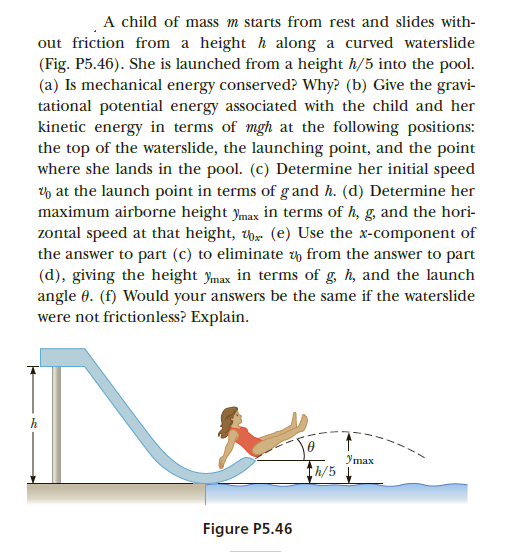A child of mass m starts from rest and slides with- out friction from a height h along a curved waterslide (Fig. P5.46). She is launched from a height h/5 into the pool. (a) Is mechanical energy conserved? Why? (b) Give the gravi- tational potential energy associated with the child and her kinetic energy in terms of mgh at the following positions: the top of the waterslide, the launching point, and the point where she lands in the pool. (c) Determine her initial speed h at the launch point in terms of g and h. (d) Determine her maximum airborne height ymax in terms of h, g, and the hori- zontal speed at that height, w (e) Use the x-component of the answer to part (c) to eliminate y from the answer to part (d), giving the height ymax in terms of g, h, and the launch angle 0. (f) Would your answers be the same if the waterslide were not frictionless? Explain. Утах th/5 Figure P5.46
A child of mass m starts from rest and slides with- out friction from a height h along a curved waterslide (Fig. P5.46). She is launched from a height h/5 into the pool. (a) Is mechanical energy conserved? Why? (b) Give the gravi- tational potential energy associated with the child and her kinetic energy in terms of mgh at the following positions: the top of the waterslide, the launching point, and the point where she lands in the pool. (c) Determine her initial speed h at the launch point in terms of g and h. (d) Determine her maximum airborne height ymax in terms of h, g, and the hori- zontal speed at that height, w (e) Use the x-component of the answer to part (c) to eliminate y from the answer to part (d), giving the height ymax in terms of g, h, and the launch angle 0. (f) Would your answers be the same if the waterslide were not frictionless? Explain. Утах th/5 Figure P5.46
College Physics
10th Edition
ISBN:9781285737027
Author:Raymond A. Serway, Chris Vuille
Publisher:Raymond A. Serway, Chris Vuille
Chapter5: Energy
Section: Chapter Questions
Problem 46P: A child of mass m starts from rest and slides without friction from a height h along a curved...
Related questions
Question

Transcribed Image Text:A child of mass m starts from rest and slides with-
out friction from a height h along a curved waterslide
(Fig. P5.46). She is launched from a height h/5 into the pool.
(a) Is mechanical energy conserved? Why? (b) Give the gravi-
tational potential energy associated with the child and her
kinetic energy in terms of mgh at the following positions:
the top of the waterslide, the launching point, and the point
where she lands in the pool. (c) Determine her initial speed
h at the launch point in terms of g and h. (d) Determine her
maximum airborne height ymax in terms of h, g, and the hori-
zontal speed at that height, w (e) Use the x-component of
the answer to part (c) to eliminate y from the answer to part
(d), giving the height ymax in terms of g, h, and the launch
angle 0. (f) Would your answers be the same if the waterslide
were not frictionless? Explain.
Утах
th/5
Figure P5.46
Expert Solution
This question has been solved!
Explore an expertly crafted, step-by-step solution for a thorough understanding of key concepts.
This is a popular solution!
Trending now
This is a popular solution!
Step by step
Solved in 7 steps with 4 images

Recommended textbooks for you

College Physics
Physics
ISBN:
9781285737027
Author:
Raymond A. Serway, Chris Vuille
Publisher:
Cengage Learning

College Physics
Physics
ISBN:
9781305952300
Author:
Raymond A. Serway, Chris Vuille
Publisher:
Cengage Learning

Principles of Physics: A Calculus-Based Text
Physics
ISBN:
9781133104261
Author:
Raymond A. Serway, John W. Jewett
Publisher:
Cengage Learning

College Physics
Physics
ISBN:
9781285737027
Author:
Raymond A. Serway, Chris Vuille
Publisher:
Cengage Learning

College Physics
Physics
ISBN:
9781305952300
Author:
Raymond A. Serway, Chris Vuille
Publisher:
Cengage Learning

Principles of Physics: A Calculus-Based Text
Physics
ISBN:
9781133104261
Author:
Raymond A. Serway, John W. Jewett
Publisher:
Cengage Learning

University Physics Volume 1
Physics
ISBN:
9781938168277
Author:
William Moebs, Samuel J. Ling, Jeff Sanny
Publisher:
OpenStax - Rice University

Physics for Scientists and Engineers, Technology …
Physics
ISBN:
9781305116399
Author:
Raymond A. Serway, John W. Jewett
Publisher:
Cengage Learning

Physics for Scientists and Engineers: Foundations…
Physics
ISBN:
9781133939146
Author:
Katz, Debora M.
Publisher:
Cengage Learning